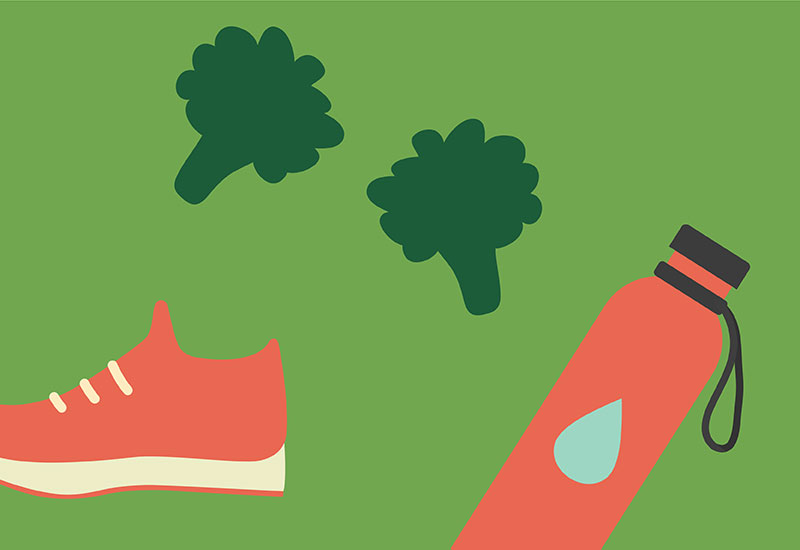A 5-Step Plan to Restore Healthy Digestion After the Holidays

The following article was written by Heinen’s Chief Dietitian, Melanie Jatsek RD, LD.
Your body is amazingly resilient! In all circumstances it seeks to maintain order and balance. To witness this for yourself, all you have to do is observe your skin as it slowly heals from a cut, scrape or bruise.
Similarly, your digestive system is patiently waiting to restore itself from the two-month-long surge of sugary treats and rich foods enjoyed at all those festive holiday gatherings.
The word restore is a hopeful word indeed. It means “to bring back to a state of health, soundness or vigor.” The beauty of this word is that it’s a given! Provided you do your part, your digestive system will return to its former self—and maybe even healthier.
I’ve created this five-step plan to help you bring your gut back into balance. I know it works because it’s my personal digestive restoration plan. Yes, dietitians are people, and they indulge too!
Step 1: Integrate Probiotics into your Daily Meals
You’ve probably heard of probiotics. They are foods or supplements containing live beneficial bacteria and are naturally present in fermented foods like Cleveland Kitchen sauerkraut and Forager cashewmilk yogurt. An abundance of healthy gut bacteria leads to optimal digestion and absorption of nutrients from the foods you eat and is also the foundation for a healthy immune system.
Add a scoop of kraut to your salad, or try this Make-Ahead Yogurt Parfait for breakfast. Bonus points for using Forager cashewmilk yogurt or any other unsweetened plant-based yogurt!

Probiotics can be found in supplement form, too. My go-to probiotic is Nutritional Roots, formulated by Heinen’s own Chief Medical Officer Dr. Todd Pesek, MD.
Step 2: Hydrate with Plenty of Water
Water makes up over 50% of your body and about 80% of your brain. It flushes waste products out of your body, prevents and alleviates constipation, and dissolves nutrients from the food you eat so that your body can use them.
Start with a minimum of 48 ounces of water each day, however you may require more based on your unique needs, including activity level, body weight, illness and thirst. Keep in mind that once you begin feeling thirsty, your body is already dehydrated, so don’t wait until you get to that point.
To determine your hydration status, simply look at the color of your urine. If it’s the color of beer or apple juice, you need more water. Urine that’s the color of straw (very pale yellow) means you’re right on track!
Step 3: Fill up on Fiber-Rich Foods
You can’t have healthy digestion without fiber. Found mostly in plants, dietary fiber is classified as soluble, insoluble and prebiotic. While all forms are essential for good health, this five-step plan focuses on insoluble and prebiotic.
Insoluble fiber serves as a “bulking” agent to move food through your intestines and keep you regular. It’s found in bran, beans, lentils, seeds, whole grains like oats and brown rice and the skins of fruits and veggies.
Prebiotic fiber is used by healthy gut bacteria as fuel to promote the growth of more beneficial bacteria. Think of it like fertilizer for good bacteria. The best sources are dandelion greens, Jerusalem artichoke (also called sunchokes), garlic, onions, leeks, asparagus, bananas, barley, oats, apples, konjac root (found in shirataki noodles), cacao, jicama, flax seeds and seaweed.

Step 4: Move your Body
Participating in daily physical activity is like giving your digestive system a massage. That’s because exercise increases blood flow to the muscles of your digestive system, helping them work more effectively. The fancy word for this is peristalsis—a series of wave-like muscle contractions that move food through the digestive tract.
The key is to choose an activity you enjoy and then do it briskly for at least 20-30 minutes. Walking, biking, stair-climbing, jogging, tennis or any other form of movement will do! When it’s too cold outside or I just don’t feel like hitting the gym, I turn on my favorite sitcom and march in place. Laughter and exercise: what a wonderful combination!
Step 5: Minimize Added Sugar
Foods with lots of added sugar tend to be highly processed and therefore lack fiber. A simple rule is to choose products with no more than five grams of added sugar per serving. This information can be discovered by looking at the food’s Nutrition Facts panel.
Note: Fresh fruits and veggies come without labels and that’s a good thing because it means they have no added sugar!
Key Takeaway
Although it varies from person to person, most people can expect positive results from this five-step plan within a week. Just be sure to take it slow, especially if you aren’t used to eating a fiber-rich diet. If you listen to your body and follow its lead, it will treat you well in return! By the way, a little extra gas is perfectly normal when you add more whole, plant-based foods into your diet. Embrace it, but just don’t share it with others!


